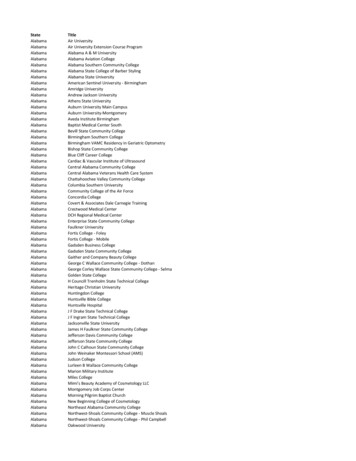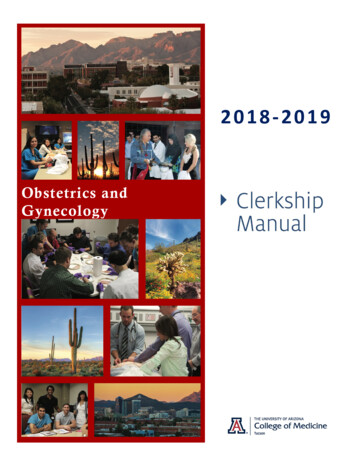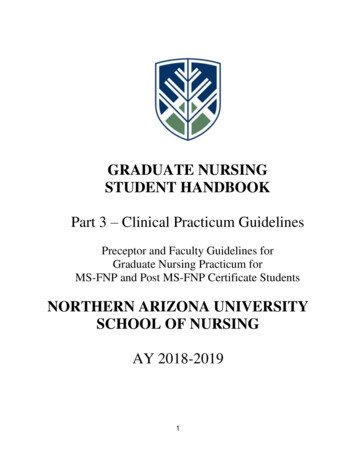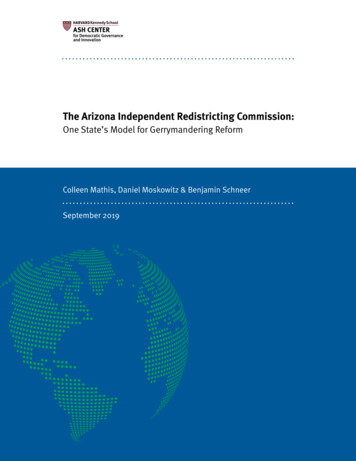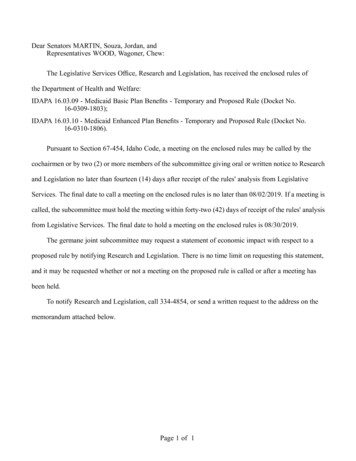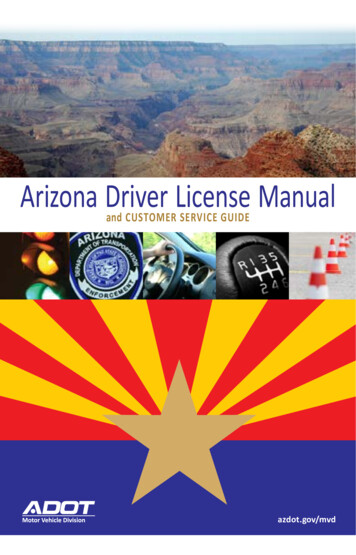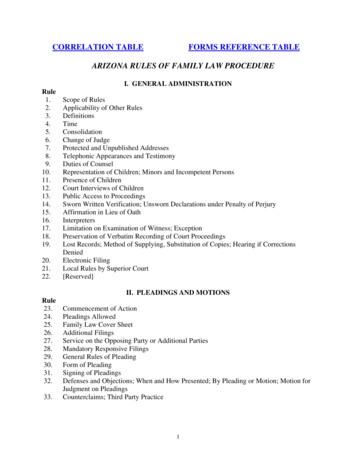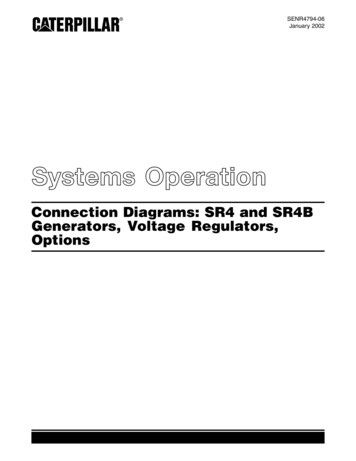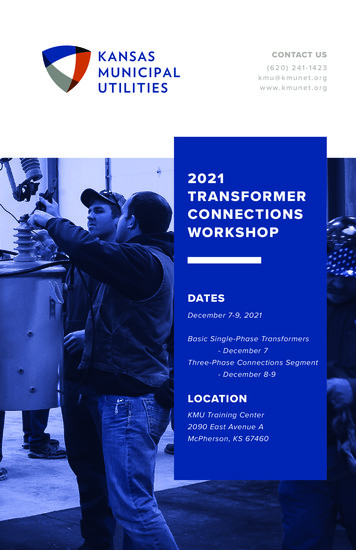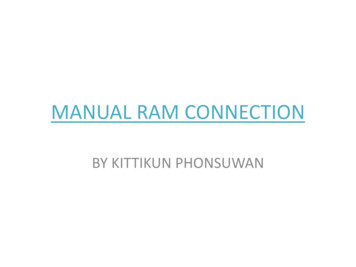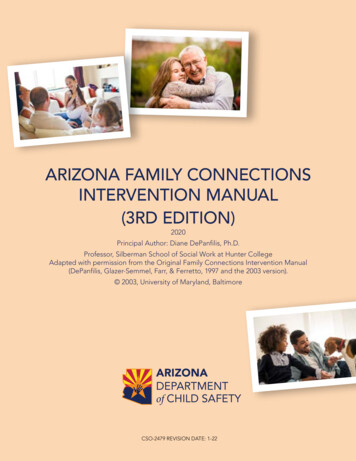
Transcription
ARIZONA FAMILY CONNECTIONSINTERVENTION MANUAL(3RD EDITION)2020Principal Author: Diane DePanfilis, Ph.D.Professor, Silberman School of Social Work at Hunter CollegeAdapted with permission from the Original Family Connections Intervention Manual(DePanfilis, Glazer-Semmel, Farr, & Ferretto, 1997 and the 2003 version). 2003, University of Maryland, BaltimoreARIZONADEPARTMENTof CHILD SAFETYCSO-2479 REVISION DATE: 1-22
TABLE OF CONTENTSCHAPTER 1: INTRODUCTION.1The goals of arizona Family Connections are to:.1FC history, synthesis of research.2CHAPTER 2: HISTORY OF FAMILY CONNECTIONS,SYNTHESIS OF RESEARCH.6Table 2-1. Background leading to the development of Family Connections.6Table 2.2 – History of Family Connections.7Family Connections Research.8What risk and protective factors have been demonstrated to change over time?.8What outcomes have been demonstrated to change over time?.8How has length of service affected risk and protective factors and outcomes?.9What length of service is most cost effective?.9What contributes to successful completion of the program?.9How does fidelity impact outcomes?.9What does qualitative research tell us about Family Connections?.9Emphasis on the helping alliance . 10Use of collaborative therapeutic assessment. 10Walking the talk. 10CHAPTER 3: PREVENTION SCIENCE, FC LOGIC MODEL& IMPLEMENTATION SCIENCE. 11Prevention Science. 11Risk factors. 11Protective factors . 11Child Welfare Intervention. 11Impending danger . 12Parent/caregiver protective capacities . 12Figure 3-1. Protective Capacities and Protective Factors . 12Arizona Family Connections Logic Model. 12Figure 3-2. Arizona Family Connections Logic Model. 13Implementation Science. 13Implementation Stages. 14Figure 3-3. Stages of Implementation. 14Exploration and Adoption. 14Installation. 14Initial Implementation. 15Full Implementation. 15Implementation Drivers. 15Figure 3-4. National Implementation Research Network’s Implementation Drivers. 16Competency Drivers . 16Table 3-1. Examples of Technical and Adaptive Challenges. 17Implementation Teams. 17CHAPTER 4: THEORETICAL BASE. 19Ecological Developmental Framework. 19Table 4-1. Ecological Developmental Framework. 19Psychosocial Theory.20Problem-Solving Theory.20Life Model Theory.20Crisis Theory.20Systems Theory. 21Figure 4-1. Environmental Interactions.22Role Theory.22TABLE OF CONTENTSpage i
Cognitive Behavior Theory.22Cognitive Theory.23Empowerment Approach.23Attachment Theory.23Trauma theory and trauma-informed care. 24Traumatic Events . 24Specific Traumas .25How Trauma Impacts a Person Throughout Life . 26Trans-Theoretical Model of Change. 26CHAPTER 5: PHILOSOPHICAL PRACTICE PRINCIPLES.28Importance of Outreach and Community.28Importance of Family Assessment and Tailored Intervention.28Importance of Developing a Helping Alliance and Partnership with the Family.29Importance of Empowerment Based-Practice.30Importance of Emphasizing Strengths.30Importance of Culturally Competent Intervention.30Developmental Appropriateness of Interventions. 31Outcome Driven Intervention. 31Positive Attitudes and Qualities of Helpers.32CHAPTER 6: ELIGIBILITY & REFERRALS.33DCS Engagement of Families during the FC Referral Process.33Family Connections Eligibility Criteria.33Family Connections Service Levels.34Family Connections Referral Process.35Re-Referral for Services.35Receiving Referrals.35CHAPTER 7: OUTREACH & ENGAGEMENT: BEGINNINGTHE FAMILY PARTNERSHIP.37Why is Outreach & Engagement Important? Key Elementsof Building a Working Relationship with Families. 37Initial Outreach with the Family. 37Intake Meeting*.38Missed Appointments .39Parent/Caregiver Declines the FC Program.40Releases of Information .40Additional Information – Communication Skills for Engagement. 41Communicating Empathy. 41Communicating Respect. 41Communicating Authenticity. 42Using Active Listening Skills. 42Additional Information – Engagement at Each Phase.43First Visit (In-Person Initial Outreach).43Preparing for the First Meeting with the Family.43Phases of the First Visit.44Additional Information – Motivated Participation .46The FCC’s Perspective on Service Facilitation and Advocacy .50CHAPTER 8: ASSESSING & RESPONDING TO CONCRETEAND EMERGENCY NEEDS.52Why is this important? . 52Concrete Services. 52Emergency Needs.53Documenting Emergency and Concrete Services.54Threat of Harm to Self or Others .55TABLE OF CONTENTSpage ii
CHAPTER 9: CONDUCTING THE COMPREHENSIVE FAMILY ASSESSMENT.56Why is comprehensive assessment important?.56Computer Assisted Self Interview (CA-Self Interview).56Comprehensive Family Assessment (CFA). 57Assessment Coordination Meeting - Initial.58Additional Information – CFA Process. 59Planning the CFA. 59Figure 9.3: Sources of Assessment Information.60Comprehensive Assessment Phases. 61Additional Information: Skills Used During the CFA Process.64Figure 9.4: MI Strategies.64Probing.64Seeking Clarification.65Reflecting Feeling and Meaning.65Partializing .65Going Beyond What is Said.65Additional Information: Outcome of the CFA.66Recognizing the Symptoms of Trauma .66Additional information. 67Exhibit 9.1: Protocol for Administering & Interpretingthe Computer Assisted Self-Interview (CA-Self Interview).68Explaining the Purpose of the CA-Self Interview.68Preparing for Facilitating the CA-Self Interview. 69To do prior to the interview:. 69Administering the CA-Self Interview with More Than One Parent/Caregiver . 69Items to take:. 69Facilitating the CA-Self Interview. 69Overview of the CA-Self Interview. 70CA-Self Interview during the CFA. . 70CA-Self Interview during the EOC/FFA-Progress Update/Service Closure. . 71Introducing the CA-Self Interview to the Parent/Caregiver. 71Exhibit 9.2 – Assessment and Screening Tools. 72Exhibit 9.3 – Comprehensive Family Assessment Summary. 73CHAPTER 10: DEVELOPING GOALS AND THE FC SERVICE PLAN.83Gathering information on other services or programs involved with the family .83Developing the family connections service plan .83Case Plan Staffing and FC Service Plan Approval Process.84Additional Information: Agency Perspective on Service Facilitation and Advocacy .84Additional Information: How to Go About Setting Goals.85Additional Information: UBSMART Criteria.86Figure 10.1: UBSMART GOAL Criteria.86Additional Information: Service Coordination of Service Planning. 87Figure 10.3: FC and Referrals to Treatment Providers. 87Exhibit 10.1: Family Connections Service Plan. 95CHAPTER 11: CHANGE-FOCUSED INTERVENTION STRATEGIES AND SERVICES.95Change-Focused Intervention. 95Documenting Change-Focused Intervention. 96Additional Information: Types of Change-Focused Intervention. 96PROVISION OF CONCRETE RESOURCES. 97SOCIAL SUPPORT INTERVENTIONS. 97INDIVIDUALLY ORIENTED INTERVENTIONS. 97Family Focused Interventions.100Service Facilitation and Advocacy.100How can FCC’s support these objectives?. 101TABLE OF CONTENTSpage iii
Additional Information: Change-Focused Intervention Skills & Techniques. 101Providing Feedback: Sharing Perceptions, Ideas, Reactions, and Formulations. 103Essentials of a Trauma-Informed Approach . 107Social Support. 112Family Functioning. 112Family Resources. 113Child Well Being. 113Parenting Attitudes & Behaviors. 114Managing Parenting Stress. 114CHAPTER 12: EVALUATING CHANGE. 115Evaluation of Change (EOC) and Progress. 115Planning for the EOC Process. 115EOC. 115Assessment Coordination Meeting - EOC. 116Considerations for Continued FC Intervention during the EOC. 117Additional Information: Planning for the EOC Process. 117Additional Information: Conducting the EOC. 117Communicating about Length of the Program. 118Additional Information: Continuation of the FC Program or After Service Closure. 118Exhibit 12.1: Evaluation of Change (EOC) Summary. 119Exhibit 12.2: Goal Progress Classifications. 131CHAPTER 13: CLOSURE AND ENDINGS - SERVICE CLOSURE. 132Why is Service Closure Important?. 132Service Closure Process*. 132Service Closure Summary. 132Additional Information: Service Closure Process. 133Additional Information: Service Closure. 133Ending Skills. 134Reviewing the process . 134Final evaluating. 134Sharing ending feelings & saying goodbye. 134Marking the end. 134Exhibit 13.1: Family Connections Service Closure Summary. 136Exhibit 13.2: Service Closure Classifications. 139CHAPTER 14: FAMILY CONNECTIONS STAFF DEVELOPMENT. 140Why is staff development important?. 140Staff Qualifications. 140Training . 140Initial Training. 140Ongoing Training. 140FC Supervision . 141Before Initial Outreach. 141After Initial Outreach & Engagement. 141During Comprehensive Family Assessment (CFA). 142During Service Planning. 143During Change-Focused Intervention. 143During Evaluation of Change. 144Before Service Closure. 144Whenever a Parent/Caregiver Declines the FC Program or Misses Appointments. 144Group Supervision . 145FC Supervision Skills & Techniques. 145Reports of Suspected Abuse, Neglect, or Safety Threats . 145TABLE OF CONTENTSpage iv
Provider Meetings . 145Additional Information: Supervision Skills & Techniques. 146CHAPTER 15: DCS AND FCC ROLES . 147Safety Assessment and Safety Planning. 147DCS specialist Role. 147Family Connections Consultant Role. 147Service Planning. 148DCS specialist Role. 148REFERENCES.
ARIZONA DEPARTMENT of CHILD SAFETY CSO-2479 REVISION DATE: 1-22 ARIZONA FAMILY CONNECTIONS INTERVENTION MANUAL (3RD EDITION
